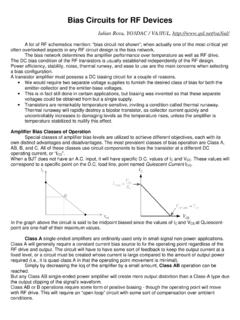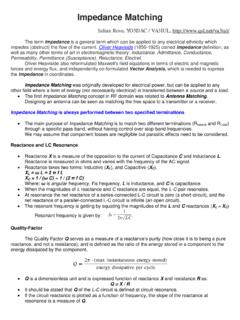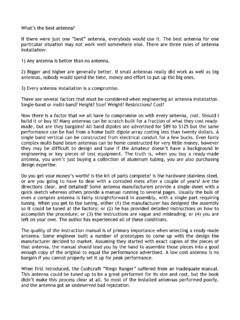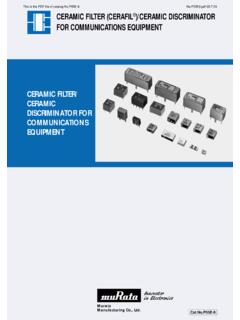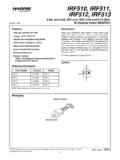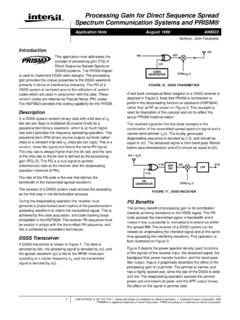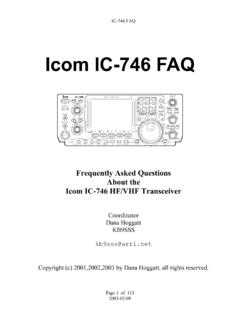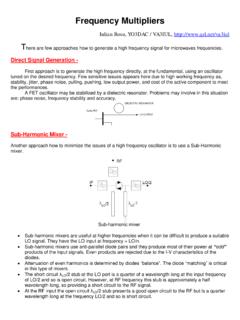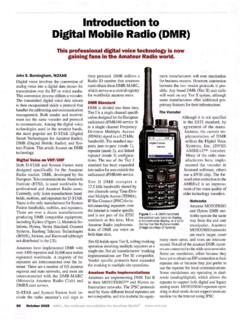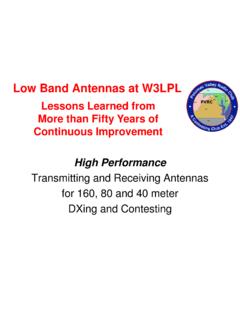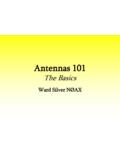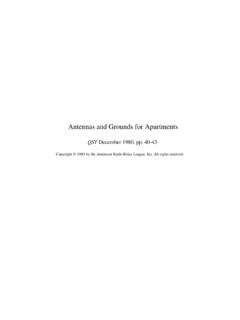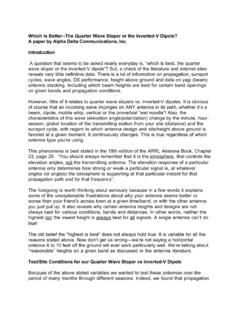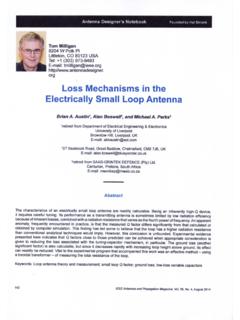Transcription of Chapter 4 PARABOLIC DISH ANTENNAS - QSL.net
1 Chapter 4. PARABOLIC DISH ANTENNAS . Paul Wade N1 BWT 1994,1998. Introduction PARABOLIC dish ANTENNAS can provide extremely high gains at microwave frequencies. A 2- foot dish at 10 GHz can provide more than 30 dB of gain. The gain is only limited by the size of the PARABOLIC reflector; a number of hams have dishes larger than 20 feet, and occasionally a much larger commercial dish is made available for amateur operation, like the 150-foot one at the Algonquin Radio Observatory in Ontario, used by VE3 ONT for the 1993 EME Contest. These high gains are only achievable if the ANTENNAS are properly implemented, and dishes have more critical dimensions than horns and lenses.
2 I will try to explain the fundamentals using pictures and graphics as an aid to understanding the critical areas and how to deal with them. In addition, a computer program, HDL_ANT is available for the difficult calculations and details, and to draw templates for small dishes in order to check the accuracy of the PARABOLIC surface. Background In September 1993, I finished my 10 GHz transverter at 2 PM on the Saturday of the VHF. QSO Party. After a quick checkout, I drove up Mt. Wachusett and worked four grids using a small horn antenna . However, for the 10 GHz Contest the following weekend, I.
3 Wanted to have a better antenna ready. Several moderate-sized PARABOLIC dish reflectors were available in my garage, but lacked feeds and support structures. I had thought this would be no problem, since lots of people, both amateur and commercial, use dish ANTENNAS . After reading several articles in the ham literature, I had a fuzzy understanding and was able to put a feed horn on one of the dishes and make a number of contacts >200 km. from Mt. Washington, in horizontal rain. However, I was not satisfied that I really understood the details of making dishes work, so I got some antenna books from the library and papers from IEEE journals and did some reading.
4 [This book is the result of several more years of reading and writing about ANTENNAS .] The 10 GHz antenna results from the 1993 Central States VHF Conference suggest that I might not be the only one who is fuzzy on the subject the dishes measured had efficiencies from 23% to less than 10%, while all the books say that efficiency should typically be 55%. On the other hand, there are enough hams doing successful EME work to suggest that some have mastered feeding their dishes. One of them, VE4MA, has written two good articles1,2 on TVRO dishes and feedhorns for EME.
5 There have been some good articles written by antenna experts who are also hams, like KI4VE3, K5 SXK4, and particularly W2 IMU5 in The ARRL UHF/Microwave Experimenter's Manual, which is an excellent starting point. However, as I struggled to understand things that are probably simple and obvious to these folks, I did some reading and then used my computer to do some of the more difficult calculations and plot them in ways that helped me to understand what is happening. Many of us find a picture easier to comprehend than a complex equation. What I hope to do here is to start at a very basic level and explain the fundamentals, with pictures and graphics, well enough for hams to implement a dish antenna that works well.
6 An accompanying computer program, HDL_ANT, is provided to do the necessary design calculations. Dish antenna Design A dish antenna works the same way as a reflecting optical telescope. Electromagnetic waves, either light or radio, arrive on parallel paths from a distance source and are reflected by a mirror to a common point, called the focus. When a ray of light reflects from a mirror or flat surface, the angle of the path leaving (angle of reflection) is the same as the angle of the path arriving (angle of incidence). This optical principle is familiar to anyone who misspent a part of his youth at a pool table!
7 If the mirror is a flat surface, then two rays of light leave in parallel paths; however, if the mirror is curved, two parallel incident rays leave at different angles. If the curve is PARABOLIC (y = ax2) then all the reflected rays meet at one point, as shown in Figure 4-1. A dish is a parabola of rotation, a PARABOLIC curve rotated around an axis which passes through the focus and the center of the curve. A transmitting antenna reverses the path: the light or radio wave originates from a point source at the focus and is reflected into a beam of rays parallel to the axis of the parabola, as shown in Figure 4-1.
8 Illumination Some of the difficulties found in real ANTENNAS are easier to understand when considering a transmitting antenna , but are also present in receiving ANTENNAS , since ANTENNAS are reciprocal. One difficulty is finding a point source, since any antenna , even a half-wave dipole at 10 GHz, is much bigger than a point. Even if we were able to find a point source, it would radiate equally in all directions, so the energy that was not radiated toward the reflector would be wasted. The energy radiated from the focus toward the reflector illuminates the reflector, just as a light bulb would.
9 So we are looking for a point source that illuminates only the reflector. Focus Geometry of PARABOLIC Dish antenna Figure 4-1. Aperture, Gain, and Efficiency The aperture, gain, and efficiency of an antenna were all defined in Chapter 1 for ANTENNAS in general. The aperture A of a dish antenna is the area of the reflector as seen by a passing radio wave: A = r 2. where r is the radius, half of the diameter of the dish. If we replace a dish antenna with a much larger one, the greater aperture of the larger is capturing much more of the passing radio wave, so larger dish has more gain than the smaller one.
10 If we do a little geometry, we find that the gain is proportional to the aperture. The gain of a dish is calculated as described in Chapter 1: GdBi = 10log10 4 2 A .. with reference to an isotropic radiator; is the efficiency of the antenna . It might be amusing to calculate the gain of the VE3 ONT 150-foot dish at various frequencies; use 50% efficiency to make the first calculation simpler, then try different values to see how efficiency affects gain. How much efficiency should we expect? All the books say that 55% is reasonable, and 70. to 80% is possible with very good feeds.
